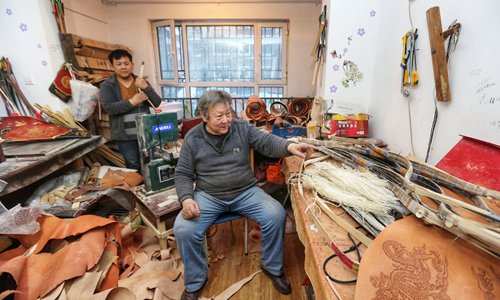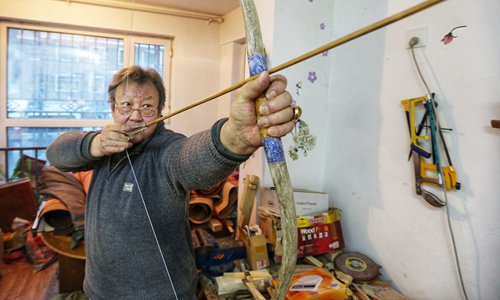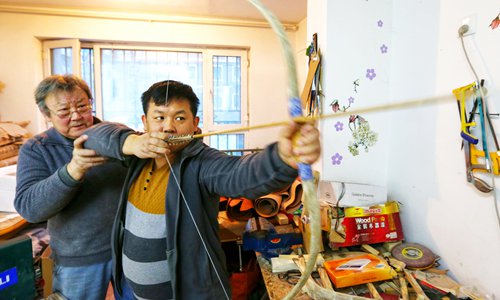
Yi Chunguang sits in his studio that he rents specifically for making bows and arrows. Photo: Cui Meng/GT
The bright Xibe traditional costumes and neat ankle boots make Yi Chunguang, a burly Xibe man in his 70s, look more robust than usual. A wall behind him at his home is covered with bows of various shapes and sizes that he made himself. These are his treasures and his pride.
Yi Chunguang, who now lives in Urumqi, Northwest China's Xinjiang Uyghur Autonomous Region, is one of the very few remaining inheritors of the Xibe bow and arrow craft. Although not so common in the modern era, the bow and arrow are in the blood of the Xibe ethnic group.
The Xibe's remote ancestors were the Xianbei, a nomadic people in Chinese history. In ancient times, the bow and arrow served as their main hunting tools as well as defensive weapons.
During the Qing Dynasty (1644-1911), Emperor Qianlong sent over 1,000 Xibe officers with outstanding archery skills from the country's three northeastern provinces, together with 1,000 of their family members, to Xinjiang to defend the northwestern borders. They travelled for 16 months on a route estimated to be more than 6,000 kilometers.
As a tribute to his ancestors, Yi began researching and teaching himself how to make Xibe horn bows in 1990. Since then, his love for the bow has grown. After years of constant efforts, he has rediscovered and refined the techniques used to make the horn bow.
Yi Chunguang is also listed as a national inheritor of the Xibe horn bow, an intangible cultural heritage.
Sophisticated production
"It takes almost one year to make a proper bow. The quality cannot be guaranteed if you try to finish it in a short time," Yi told the Global Times.
The traditional Xibe bow is about 1.6 meters long and weighs nearly 1 kilogram. Visitors to Yi's studio are often eager to test their arm strength on the bow, but most of them can only pull it half way.
Yi would proudly take over and swiftly draw the arrow back, narrowing his eyes slightly and aiming straight ahead, looking like a valiant Xibe hunter. It is hard to believe that he's in his 70s and suffers from a serious degenerative bone disease, which causes great inconvenience in his movements.
In 2001, he found a bow and arrow brought over by his Xibe ancestors when they moved from the northeast to Ili, Xinjiang, hundreds of years ago.
"The bow and arrow were so delicate, and the bow was still wrapped in beef sinews. I was immediately hooked, and couldn't stop looking at it," he recalled.
Saying he wanted to repair the bow, he borrowed it and took it apart, discovering that the bow's body was made of wild goat horn and highly elastic. The handle of the bow was made from the thigh bone of an ox, which increases its thrust. This primitive Xibe bow was at least 400 years old.
He recorded the size of the bow, its curvature, and the materials it was made from.

Yi Chunguang shows his bow and arrow. Photo: Cui Meng/GT
In order to better understand the essence of the Xibe bow and arrow, he spoke to many elderly Xibe people and read many ancient books on the subject.
After years of careful research and using the model as reference, Yi designed, engraved, and varnished a bow himself, finally making the first Xibe traditional horn bow in half a century.
"The bow and arrow is a kind of faith for me. In Xibe culture, men who shoot well are popular. They become more holy and respected when they die," he told the Global Times.
Over the past decade, Yi has become a main representative of Xibe archers due to his outstanding craftsmanship. Even in extremely wet conditions, his wooden bow and arrow still retain their shape.

Yi Chunguang teaches his younger son the proper way to shoot. Photo: Cui Meng/GT
Precious inheritance
In 2003, he established a bow and arrow studio called "The Xilidan (Xibe word for "arrow")," to develop and research traditional bows and arrows made from different materials, together with his second son Yi Chunyong, who is also the inheritor of this intangible cultural heritage.
But they are at odds over how the craft should be passed on. The son believes that cultural products should generate economic benefits, while
the father disapproves of mass production due to concerns over the ecological damage done by collecting raw materials for making the weapon.
Yi Chunguang is never satisfied with merely restoring the lost craft. He has also developed a different series of bows and arrows, the longest of which is 1.72 meters and the shortest is 70 centimeters. He even tried using various modern materials such as fiberglass, which can give the bow a range of more than 150 meters.
More importantly, he trains youngsters and encourages local students to take an interest in the art. So far, he has taken in more than 20 apprentices.
He also comes up with artistic decorations for his bows and arrows, sewing traditional adornments onto the quivers.
"Inheriting the Xibe bow and arrow means you mustn't lose its cultural characteristics," Yi Chunguang said. He has applied for eight national patents on its design and structure.
With the help of his second son, he set up a website dedicated to the study of traditional Chinese bows and arrows.
Unfortunately, few young people are interested in making bows and arrows now. Yi is concerned that the skill is likely to soon be lost.
"Although bows and arrows are no longer practical in modern society, the centuries-old art of bow-making should not disappear," he told the Global Times.
Understanding his father's concerns, his younger son has now become one of his apprentices, learning the ancient art step by step.
The animal horns used to make the bow should also be carefully selected. Not only should the age of the animal be taken into account, but horns that are fractured when the animals collide with each other should also be avoided, Yi Chunguang warned his apprentices. "It is never easy to select an ideal pair of animal horns. Usually only one out of ten or even a few dozen will do," he said.
Yi Chunguang has won a long list of accolades both in bow and arrow exhibitions and major international shooting competitions.
In 2019, the family successfully applied for annual funding from the national art fund, allowing their works to be exhibited in four provinces around the nation and showcasing Xibe ethnic culture to the country.
This will also help in the next step of their plan to promote the "bow and arrow culture" in universities, and then into wider society.

